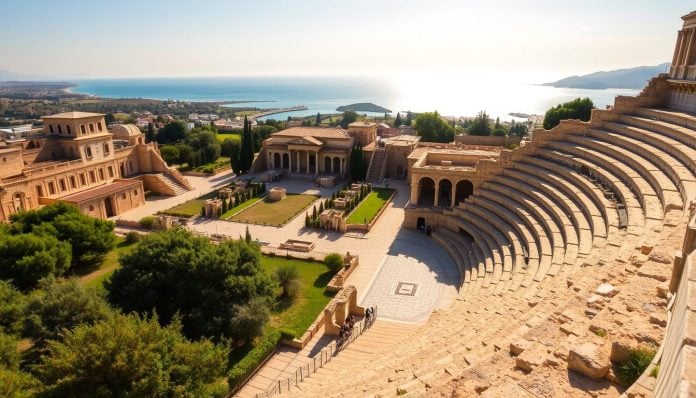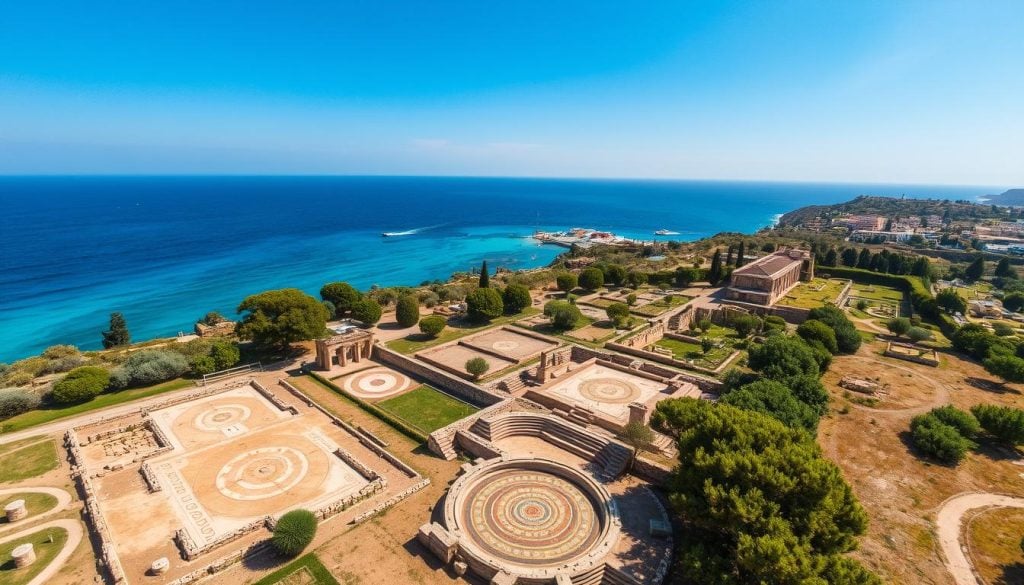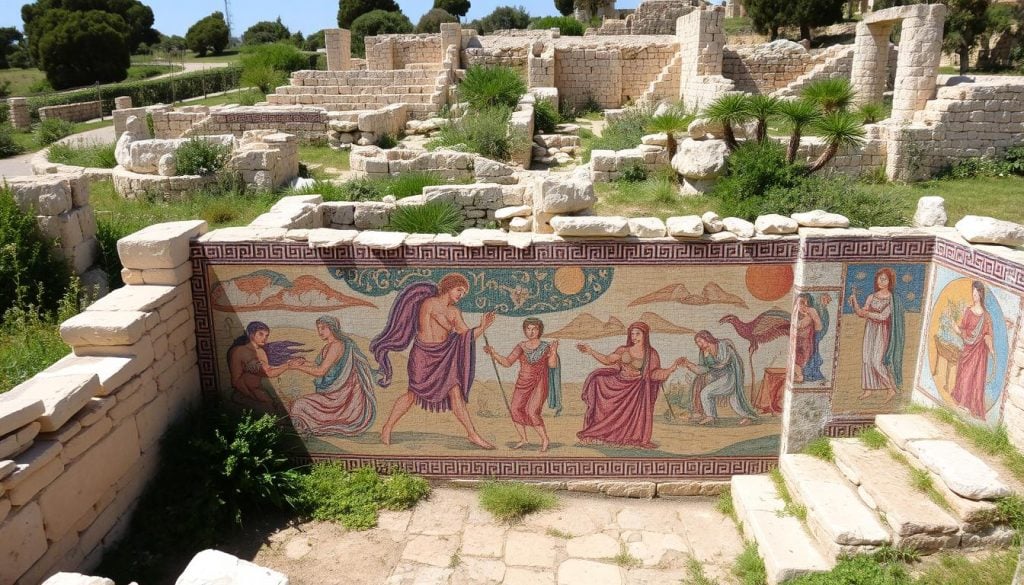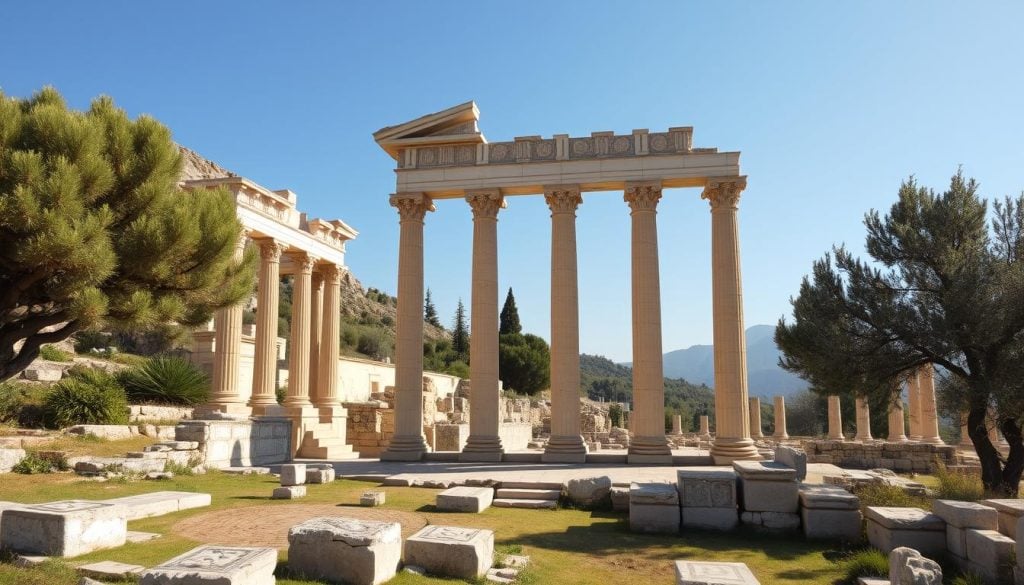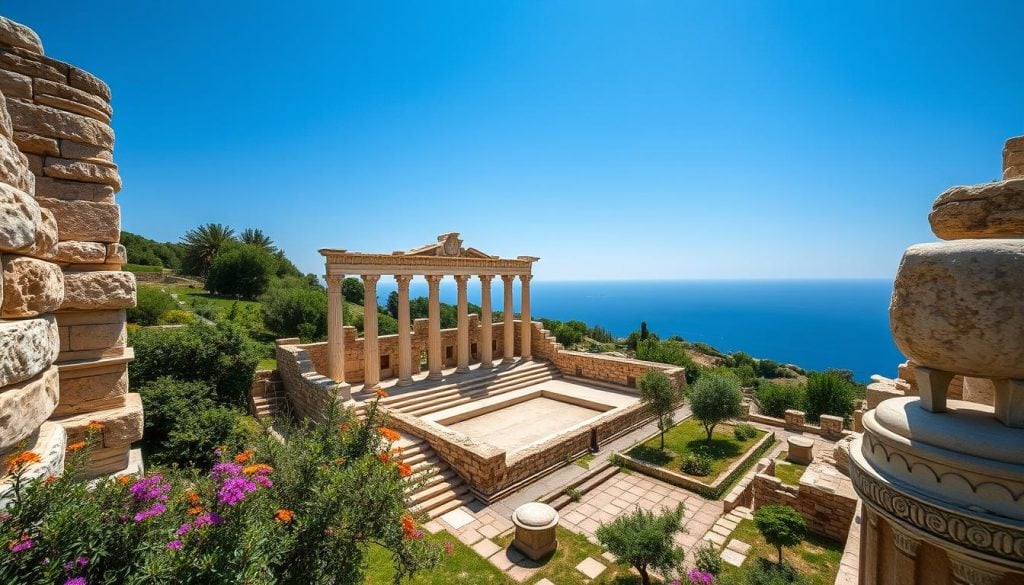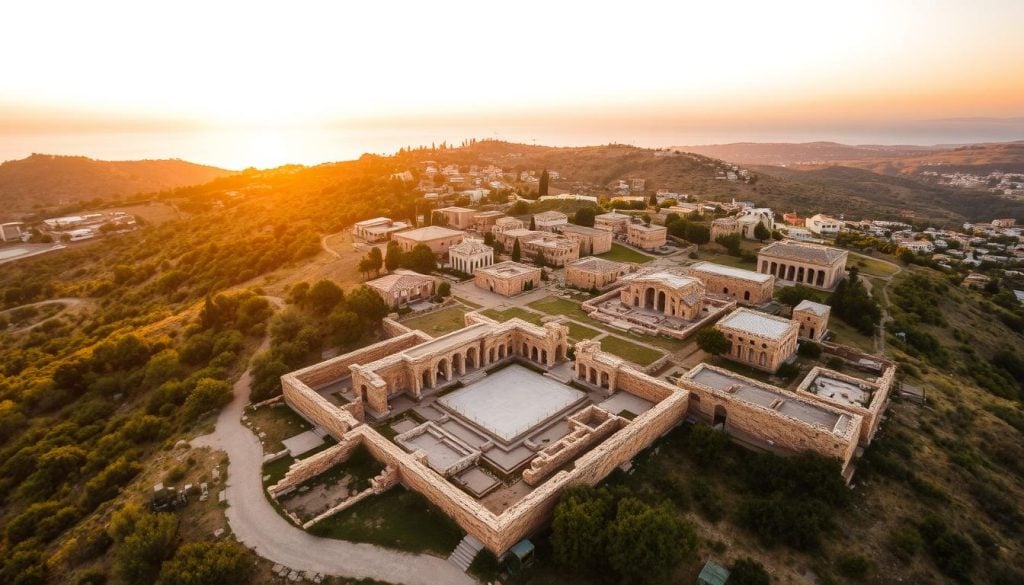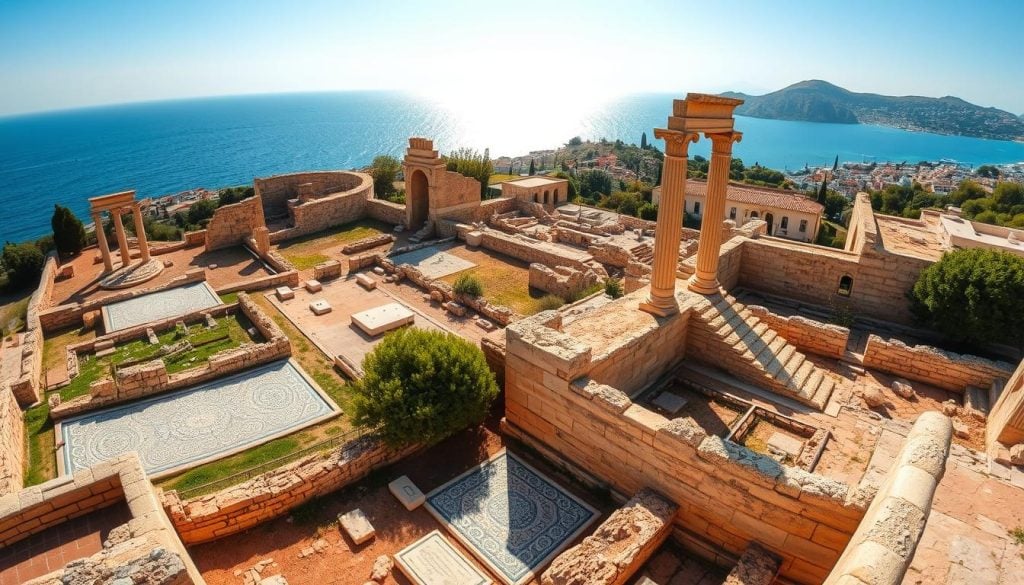Have you ever wondered how a single place can hold centuries of history, art, and myths? Welcome to Paphos, a beautiful coastal town in Cyprus. Here, the Paphos UNESCO World Heritage sites let you explore a rich tapestry of ancient civilization. This UNESCO status, given in 1980, shows the city’s key role in culture and governance through time.
Walking through Paphos, you’ll find amazing monuments. They show the city’s historical value and its link to Aphrodite, the goddess of love. You’ll see detailed mosaics and ancient burial sites. Paphos gives a unique look into the past, inspiring visitors from all over.
Introduction to Paphos and Its Rich History
Paphos is a city on Cyprus’s southwestern coast. It has a rich tapestry of history that goes back to ancient times. During the Roman Empire, it was Cyprus’s capital, a hub of culture and commerce.
The city’s transformation from ancient Palaepaphos to modern Kato Paphos shows great progress in architecture and urban planning.
Exploring ancient archaeological sites in Paphos gives us a peek into the lives of its people. Excavations have uncovered temples, fancy villas, and public buildings. These finds highlight the city’s historical significance.
Each site shares a piece of Paphos’s story, showing how it has changed over time.
Now, Paphos is a lively tourist spot, mixing its history with modern life. Its beautiful landscapes and cultural heritage attract many visitors.
Paphos UNESCO World Heritage Sites: An Overview
The UNESCO World Heritage Sites in Paphos give us a peek into ancient Cypriot life. You’ll find many sites that show Paphos’s long history. Key places include Kato Paphos Archaeological Park, the Tomb of the Kings, Palaepaphos, and the House of Dionysus.
These sites share interesting parts of the region’s past. They keep monumental artworks and buildings that show the area’s cultural importance. The mosaics, temples, and tombs show the skill and creativity of ancient people. Seeing these sites lets you understand their historical value to both local and global heritage.
Visiting the UNESCO World Heritage Sites in Paphos takes you on a journey through history and culture. Each site tells a story of the area’s lasting legacy. It invites visitors to connect with these stories.
The Kato Paphos Archaeological Park
The Kato Paphos Archaeological Park is a window into ancient Roman grandeur. It’s a UNESCO World Heritage site that shows off the past. You’ll see remnants of luxurious homes and artifacts that tell us about the lives of those who lived there.
Walking through the park, you get to see the history and beauty of the grand structures. These buildings once belonged to the elite of Paphos.
An Insight into Ancient Life
At the Kato Paphos Archaeological Park, you see the richness of ancient life. The park has many structures, including Roman villas in Paphos. These villas show the luxury of the time.
Each villa gives us a peek into the daily lives, social norms, and art of the people who lived there. It’s easy to imagine how life was in these grand homes.
Significant Mosaics and Roman Villas
The mosaics in the Kato Paphos Archaeological Park are truly stunning. They cover the floors of the Roman villas in Paphos. These mosaics show scenes from myths and nature, full of color and detail.
As you walk through, you see the skill of ancient artists. Each mosaic tells a story, showing the culture and beliefs of ancient Paphos.
| Feature | Description |
|---|---|
| Site Type | Archaeological Park |
| Historical Period | Roman Era |
| Location | Kato Paphos, Cyprus |
| Notable Art | Mosaics depicting mythological themes |
| Architectural Highlights | Roman villas and public buildings |
The Tomb of the Kings: A Necropolis of Note
The Tomb of the Kings Paphos is a grand tribute to ancient burial customs. It’s a site known for its architectural skill and deep history. It invites visitors to see its detailed design and its deep meaning.
Architecture and Design of the Tombs
The Tomb of the Kings is famous for its rock-hewn structures. These tombs were built for the elite, with grand columns and big chambers. The wall paintings show the artistry of the time.
The design mixes local and Hellenistic styles. This shows the creative influences in ancient Paphos.
Historical Significance and Insights
The Paphos necropolis is rich in history. It shows burial customs from the 4th century BC to the 3rd century AD. It reflects the social hierarchy of ancient Cyprus.
Each tomb tells us about the beliefs and practices of death and the afterlife. It invites us to think about life’s big questions. These ancient chambers offer a fascinating story of those who were buried here.
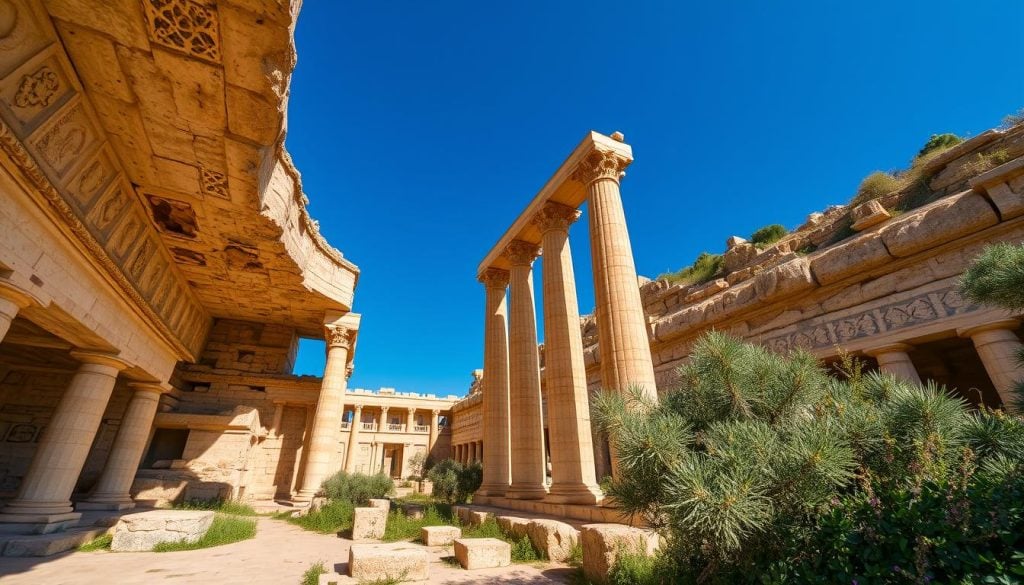
| Feature | Description |
|---|---|
| Architectural Style | Combines local and Hellenistic influences |
| Tomb Design | Rock-hewn with grand columns and chambers |
| Historical Timeline | 4th century BC to 3rd century AD |
| Cultural Insights | Reflects burial customs and societal hierarchy |
| Artistic Elements | Elaborate wall paintings depicting ancient life |
Palaepaphos: The Old City of Paphos
Palaepaphos is known as the ancient heart of Paphos. It’s a key part of Cyprus’s culture and spirituality. This site shows how cities and religions evolved over time.
Historical Context and Development
The history of Palaepaphos goes back to ancient times. It was a major center for trade and spirituality. Its location drew traders and pilgrims, making it thrive.
Over the years, the city changed, influenced by different cultures. From the Mycenaean to the Hellenistic period, it grew. Today, we can see its history in the archaeological layers.
The Sanctuary of Aphrodite and Its Findings
The Sanctuary of Aphrodite is at the heart of Palaepaphos. It was a sacred place for the goddess of love and beauty. Visitors can see the remains of the temple and learn about ancient worship.
The site’s artifacts are amazing. They include statues, pottery, and a basalt stone. These items show how much the ancient Cypriots revered Aphrodite. They mix mythology and culture, telling Palaepaphos’s story.
House of Dionysus: Stunning Mosaics and Art
The House of Dionysus Paphos is famous for its stunning ancient mosaics. Located in the Kato Paphos Archaeological Park, it showcases incredible designs. These tell the stories of Dionysus, the god of wine and fun.
Visitors are amazed by the colorful scenes of feasts and celebrations. These show the lively culture of the Roman era.
The mosaics focus on Dionysian themes, showing the community’s love for festivals. Each piece is not just decoration. It highlights the importance of worship and nature’s gifts, especially in wine.
These ancient mosaics help you understand the local heritage. They make your visit to this historic area even more special.
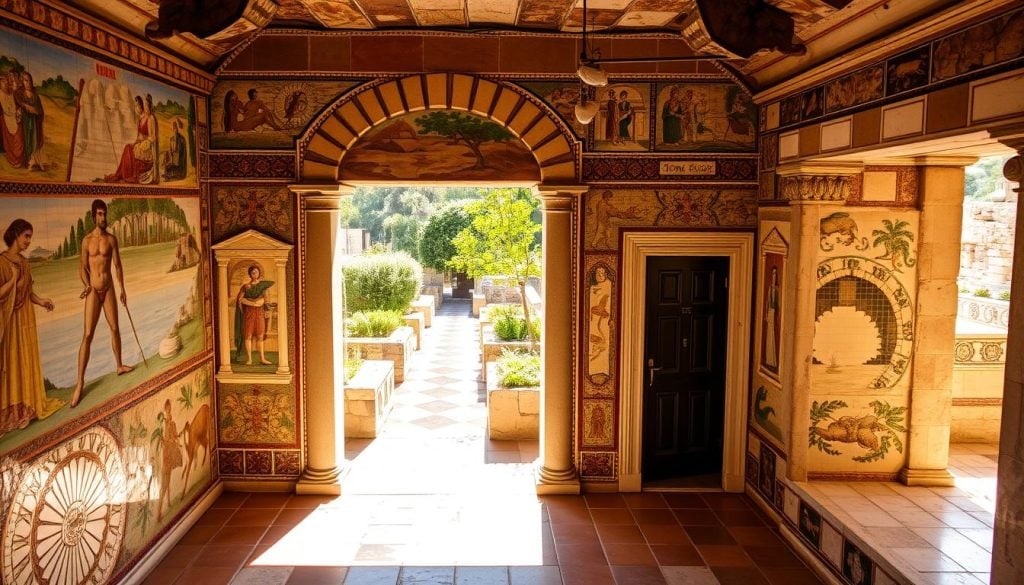
See the House of Dionysus for yourself. Let the mosaics take you back to a time when art and myths were one. It shows the cultural heart of ancient Paphos.
| Feature | Description |
|---|---|
| Mosaic Themes | Scenes of Dionysian festivities and mythology |
| Artistic Technique | Use of vibrant colors and detailed patterns |
| Cultural Significance | Reflects local traditions and worship practices |
| Visitor Experience | Immersive journey through ancient Roman life |
Visiting the Agora and the Odeon of Paphos
Visiting the Agora Paphos and the Odeon of Paphos takes you back in time. Here, civic life was vibrant, with people coming together for trade, entertainment, and socializing. These ancient sites offer a unique look into the lives of those who once called this place home.
Exploring Ancient Civic Life
The Agora was the heart of commerce in ancient Paphos. It was more than a market; it was a place for socializing. Citizens would meet here to trade goods, share news, and exchange ideas. Walking through the Agora, you can imagine the lively conversations and deals made.
The Role of the Odeon in Roman Paphos
The Odeon of Paphos, near the Agora, showcases the city’s rich cultural heritage. This Roman theatre hosted performances and public events. Its design shows the advanced engineering skills of the Romans. You can almost hear the cheers and applause of the past, as people gathered to enjoy art and culture.
| Aspect | Agora Paphos | Odeon of Paphos |
|---|---|---|
| Function | Marketplace and gathering area | Roman theatre for performances |
| Social Role | Community engagement and trade | Cultural entertainment |
| Structure Type | Open space with columns | Amphitheater design |
| Historical Importance | Commercial heart of ancient Paphos | Center of artistic expression |
Cultural Significance of Paphos World Heritage Sites
Paphos is a treasure trove of history, blending Greek, Roman, and local traditions. These UNESCO sites are guardians of Paphos’s heritage. They tell the tales of a civilization that thrived in the Mediterranean.
Visiting these sites lets you see how different styles merged. Sacred and civic buildings show Paphos’s role in ancient times. They are key to understanding Cypriot history and culture.
Efforts to preserve these sites protect Paphos’s rich heritage. They also teach visitors about history and culture’s link. Walking through these places fills locals with pride, connecting them to their ancestors’ achievements.
Exploring these treasures uncovers a shared cultural story that goes beyond time. It’s a journey through history, art, and philosophy.
How to Access and Experience Paphos Heritage Sites
Getting to the UNESCO World Heritage Sites in Paphos is easy. Paphos International Airport is the closest, just 15 kilometers from the city center. It welcomes flights from across Europe, making it simple for visitors to arrive.
There are many ways to get around Paphos. Renting a car gives you freedom to explore at your own speed. Public buses are a reliable choice, taking you to key attractions. Walking in Kato Paphos is also a great way to see the Archaeological Park and the medieval castle.
Choosing the right time to visit can make your trip better. Spring and fall offer mild weather and fewer people, allowing for a deeper connection with the sites.
| Transportation Option | Details |
|---|---|
| Rental Cars | Provides flexibility and ease of access to various sites. |
| Public Buses | Cost-effective option with routes covering major attractions. |
| Walking | Ideal for short distances, particularly within Kato Paphos. |
| Bicycles | A fun way to explore the city and heritage areas at your leisure. |
Remember these tips as you plan your trip to Paphos. They will help make your visit unforgettable.
Conclusion
Paphos is a top spot for history buffs, with amazing UNESCO World Heritage Sites. You can see the Tomb of the Kings, the Kato Paphos Archaeological Park, and the House of Dionysus. These places show the city’s deep history and culture.
The city’s stories are linked to gods like Aphrodite and Roman architecture. It’s a mix of myth and history. Exploring these sites lets you learn more about heritage and culture. It’s a journey into the heart of an ancient world.
If you’re looking for your next adventure, think about Paphos. It has incredible ancient sites and a rich history. Your visit will be unforgettable, making you appreciate history more. So, start planning your trip to Paphos today and discover its beauty.

































